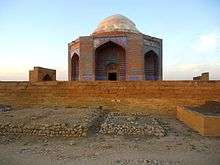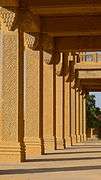Makli Hill
 Tomb of Prince Sultan Ibrahim bin Mirza Muhammad Isa Tarkhan, Makli Hill | |
 Location of Makli Hill, Pakistan | |
| Details | |
|---|---|
| Location | Thatta |
| Country | Pakistan |
| Coordinates | 24°45′13″N 67°53′59″E / 24.753589°N 67.899783°E |
| Type | Sufi |
| Number of graves | 125,000 |
| Official name | Historical Monuments at Makli, Thatta |
| Type | Cultural |
| Criteria | iii |
| Designated | 1981 (5th session) |
| Reference no. | 143 |
| State Party | Pakistan |
| Region | Asia-Pacific |
Makli Hill is one of the largest necropolises in the world, with a diameter of approximately 8 km. It lies approximately 98 km east of Karachi and is the burial place of some 125,000 local rulers, Sufi saints and others. Makli is on the outskirts of Thatta, the capital of lower Sindh until the 17th century, in what is the southeastern province of present-day Pakistan.[1] It was added to the World Heritage List in 1981[2] under the name Historical Monuments of Thatta.
History
Legends abound about its inception, but it is often believed that the cemetery grew around the shrine of a 14th-century Sarwa, Muhammad Hussain Abro. According to other sources, however, the credit for establishing Makli as a holy place for worship and burial goes to the immigrant saint, poet and scholar Shaikh Hammad Jamali and the then local ruler, Jam Tamachi.[3] Another legendary person buried at Makli is the saint Pir Murad (1428-1488).
The tombs and gravestones spread over the cemetery mark the social and political history of Sindh. Many have been build using a local sandstone; others are plastered brick buildings (which have suffered the most, generally).
The impressive royal mausoleums are divided into two major groups: those from the Samma (1352–1520) and from the Tarkhan (1556–1592) period. Four historical periods are represented architecturally — the Samma, the Arghun, the Tarkhan and the Mughals periods.
The tomb (or maqbara) of the King Jam Nizamuddin II (reigned 1461–1508) is an impressive square structure built of sandstone and decorated with floral and geometric medallions. Similar to this is the mausoleum of Isa Khan Hussain II (d. 1651), a two-story stone building with majestic cupolas and balconies. In contrast to the synthetic architecture of these two monuments, which integrate Hindu and Islamic motifs, are mausoleums that clearly show the Central Asian roots of the Tarkhan and Moghul dynasties. An example is the tomb of Jan Beg Tarkhan (d. 1600), a typical octagonal brick structure whose dome is covered in blue and turquoise glazed tiles. Pavilion or canopy tombs (chattri maqbara or umbrella tomb) are another typical Indo-Islamic architectural feature, as well as enclosure tombs. The Moghul period is represented by many tombs on the southern side of the necropolis, including the mausoleum of Mirza Jani and Mirza Ghazi Baig, that of Nawab Shurfa Khan, the enclosure of Mirza Baqi Baig Uzbek and of Mirza Jan Baba as well as the impressive restored tomb of Nawab Isa Khan Tarkhan the Younger.
Today, Makli Hill is a United Nations Educational, Scientific and Cultural Organization (UNESCO) World Heritage Site that is visited by pilgrims and tourists, but is in strong need of conservation and maintenance. Flooding in 2010 added to the deterioration of the site.[4]
- Sketch plan of the necropolis as stated by information point
- Tombs at Makli hill
- Quranic artwork at a decorated grave of a Sufi saint in the necropolis
 Portico of tomb of Nawab Isa Khan the Younger
Portico of tomb of Nawab Isa Khan the Younger- Canopy tomb of Daya Khan Rahu
See also
- List of UNESCO World Heritage Sites in Pakistan
- List of mausolea
- List of forts in Pakistan
- List of museums in Pakistan
References
- ↑ www.bookrags.com
- ↑ Historical Monuments at Makli, Thatta UNESCO World Heritage Centre. Retrieved 10 February 2011
- ↑ Lari, Suhail Z. and Lari, Yasmeen, The jewel of Sindh; Samma monuments on Makli Hill. Heritage Foundation/Oxford University Press. Karachi, 1997.
- ↑ Damage Assessment Mission to the Necropolis of Makli, Heritage Foundation, supported by the Prince Claus Fund for Culture and Development, Karachi (2011).
External links
| Wikimedia Commons has media related to Makli Hill. |
- Oriental Architecture - Makli Necropolis
- Makli Hill Photo Gallery
- Illustration of Sind Tiles
- Ayaz Asif's photo collection of the Makli Hills and the Shah Jahan Mosque.
- Archnet.org Digital Library (Photographs)
- Two Monuments on Makli Hill
- http://www.fotopedia.com/items/4vlcmdk21v1b9-sL5b9ds78r0
- http://www.fotopedia.com/items/4vlcmdk21v1b9-Rby790BKO18
- http://www.fotopedia.com/items/4vlcmdk21v1b9-sL5b9ds78r0
Coordinates: 24°45′13″N 67°53′59″E / 24.7535°N 67.8997°E
